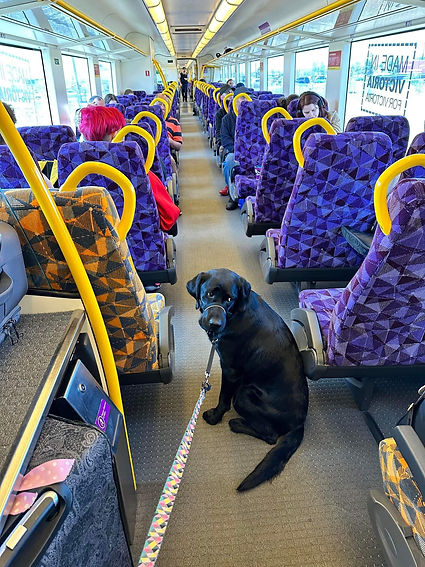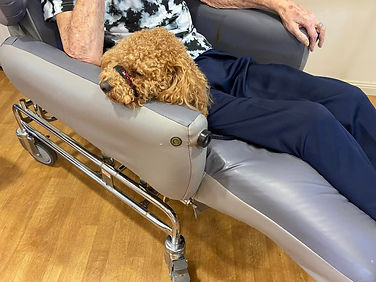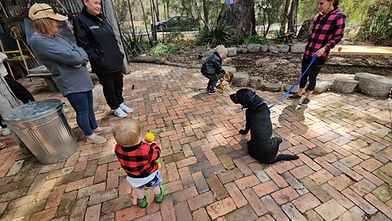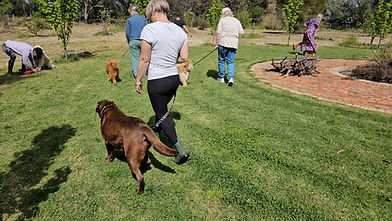
Victorian Assistance Dogs:
All you need to know
On this page I provide you with the legal definition of assistance dogs and what it means for us in Victoria specifically. I will also outline the services I offer to help you with assistance dog certification. If you are in another state, please refer to your state’s assistance dog regulations as these guidelines are specific to Victoria’s legislation only.
Please note, when it comes to explaining the legalities of assistance dogs, I am going to refer and quote from other sources to ensure you gain the most up to date information in the most accurately worded way possible. I will then provide commentary where commentary is needed for ease of understanding. Wherever words are not found within “” these are my own words, and where words are quoted, I always give the source.
It is important to understand that no course is a guarantee that your dog will be successful in their registration as every course, from every business, must hold participants to external standards.
I hope this page provides much needed clarity in what can otherwise feel a very confusing world.
Many thanks,
Annie
What is an assistance dog?
“Assistance Dog is a generic term for a guide, hearing, or service dog specifically trained to perform identifiable physical tasks and behaviours to assist a person with a disability in order to aid in quality of life and/or independence. Assistance dogs are covered under many legislative access laws for public access rights when working with their handler who lives with a disability. All dogs can intrinsically provide emotional support to a human being. Assistance dogs are different from emotional support dogs in that they are specifically trained to perform identifiable tasks to increase independence and/or quality of life.”
Taken from: www.assistancedogs.org.au;
“The Disability Discrimination Act 1992 (DDA) Section 9, sets out the legal definition of an assistance animal as a dog or other animal that is:
(a) Accredited under a State or Territory law to assist a person with a disability to alleviate the effects of disability; or
(b) Accredited by an animal training organisation prescribed in the regulations; or
(c) Trained to assist a person with a disability to alleviate the effect of the disability and meets standards of hygiene and behaviour that are appropriate for an animal in a public place.”
Taken from: https://humanrights.gov.au;
My commentary: Helping you understand what this means-
An assistance dogs needs to perform tasks that you require for a condition you live with.
These tasks cannot include helping you feel loved or valued. Instead, the legal requirement is that your dog provides a function that you need for a diagnosed condition you live with (i.e. a medical alert dog that tells you when your blood sugar levels are low; or a physical mobility dog that helps you pick up objects that you can’t otherwise reach etc).
Because assistance dogs are providing a need for their owner, they are allowed public access (i.e. they can go with you into the supermarket). Therapy dogs, emotional support dogs, companion dogs etc. do not have this same unbridled access.

Requirements of Victorian Assistance Dogs

%20Instagram.png)




“Your assistance dog must also have completed obedience, including assessment in the following skills:
-
heeling or walking with a handler, without sniffing, marking or wandering
-
sociability with other dogs
-
responsiveness to a handler’s commands, including staying on command (known as a stay test) and coming to a handler on command (known as a recall test)
-
absence of aggression towards humans or other animals
-
absence of anxiety, stress, fear, or undue excitement when in public places, and
-
standard of hygiene appropriate for a public place.
This training needs to be completed by a dog trainer and be evidenced by an obedience certificate and a declaration by the relevant dog trainer. The obedience training will need to be provided by a person who either:
-
holds a qualification in Certificate III in Dog Behaviour and Training or
-
a Certificate IV in Companion Animal Services or•is a qualified dog obedience trainer with one of the following Ministerially approved dog obedience training organisations
-
Australian Association of Professional Dog Trainers Inc
-
Four Paws K9 Training
-
The Kintala Dog Club Association Inc.
-
Delta Institute
The owner of an assistance dog must demonstrate that:
-
they have a disability as defined under the Commonwealth Disability Discrimination Act 1992 (DDA Cth)
-
the assistance dog is trained to perform tasks or functions that assist to alleviate the effect(s) of that disability (as per the definition of assistance dog under the Equal Opportunity Act 2010).
In addition to the above, your assistance dog needs to:
-
be desexed
-
be microchipped
-
be at least 12 months of age
-
be proven to have completed obedience training provided by a dog trainer.
Note: The obedience training can either be completed separately, or as part of the training undertaken to perform tasks or functions that assist the person with a disability to alleviate the effects of their disability.
-
not be a dangerous, menacing, or restricted breed dog.
Under the Disability Discrimination Act 1992, a person may request that a person with a disability produce evidence that an animal is an assistance animal. Given that an assistance animal – in this case an assistance dog – is distinguished by being trained to alleviate the effect of a disability, it is appropriate to ask for evidence that the animal is required for this purpose.
Evidence of a disability (as defined under the Disability Discrimination Act 1992) necessitating you to be accompanied by your assistance dog may include a:
-
declaration from a health professional as part of a registration application form, or
-
a written recommendation from and/or a declaration by the relevant treating medical practitioner to verify that you have a disability and will require the assistance of an assistance dog.”
HELPING MAKE SENSE OF THIS:
All assistance dogs in Victoria require their owner to have a diagnosed condition/disability. This means, you cannot be self-diagnosed, or just want your dog to be with you because they make you feel better. A specialist/general practitioner is required to have diagnosed you with a disability in order for you to qualify for an assistance animal in Victoria. You will need to carry with you a letter from your medical practitioner to this effect.
All assistance dogs in Victoria must perform several identifiable tasks that alleviate the effect of your disability. In Victoria "emotional support" is not considered a task that would satisfy the standard of an assistance dog. Examples instead include: Making the bed for someone with a physical disability; Creating space for someone who has PTSD; Providing grounding for someone on the ASD spectrum; and the list goes on.
All assistance dogs in Victoria must be well kept, which includes their hygiene, grooming requirements and toilet training.
All assistance dogs in Victoria must be behaviourally and temperamentally sound. They cannot bark, growl or be otherwise reactive if someone was to approach them. This also exists for their environment also - they cannot be reactive toward bikes, cars, other dogs, loud noises and the list goes on.
Finally, all assistance dogs need to be obedient, being controllable by you at all times. This obedience needs to be assessed by a Certificate III obedience trainer or higher.
What about a Public Access Test (PAT)?

“Other Australian states require assistance animals to pass a Public Access Test. This assesses an animal’s ability to work and behave as an assistance animal in public places, including on public transport.
Assistance animals need to be:
-
non-aggressive
-
obedient to their handler's commands
-
quiet (no barking)
-
experienced in real life situations
-
calm in confined and crowded spaces
-
calm in noisy and stressful situations.
In Victoria your animal doesn’t need to complete a Public Access Test, but we strongly recommended that your trainer use the requirements as a guide to minimum standards of behavior and hygiene.”
Taken from: https://www.ptv.vic.gov.au/
My commentary: Helping you understand what this means-
There is no Victorian PAT for your assistance animal to complete. It is still a good idea to use another State's PAT test to help prepare your dog prior to your assessment.
You can find Queensland's public access test here: https://www.qld.gov.au/__data/assets/pdf_file/0032/88655/pat-certification-handler-card-form.pdf
Requirements of your assistance dog
The following outlines briefly what has been discussed above, and breaks down what you need to do for your dog to become an assistance dog into 4 key areas: Obedience; Temperament and Public Experience; their Role; and their assessment and proof.
Services I offer that can help you achieve the assistance dog standards
While it is entirely possible for you to train your own assistance dog in Victoria, there is a reason many don't. Namely, because it's incredibly difficult. If you need help achieving a certain standard, these are the services I provide which can help you achieve your goal. You can choose any from the list and I will help you with that area.
Contact
If you would like to chat further about an assistance dog pathway that works for you, please call me on: 0473 739 067. All assistance dogs that I train need to first enrol through phone call rather than email or message, as this enables me to ensure we are both on the same page.







